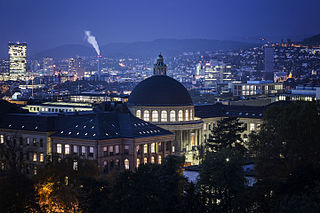
The four national languages of Switzerland are German, French, Italian, and Romansh. German, French, and Italian maintain equal status as official languages at the national level within the Federal Administration of the Swiss Confederation, while Romansh is used in dealings with people who speak it. Latin is occasionally used in some formal contexts, particularly to denote the country.
The University of St. Gallen (HSG) is a research university located in St. Gallen, Switzerland, that specialises in business administration, economics, law, international affairs, and computer science. It was established in 1898. It consistently ranks as one of the best business schools in Europe. In 2022, it had 9,590 students, of which 3,757 were master's students and 584 were doctoral students.

The education system in Switzerland is very diverse, because the constitution of Switzerland delegates the authority for the school system mainly to the cantons. The Swiss constitution sets the foundations, namely that primary school is obligatory for every child and is free in state schools and that the confederation can run or support universities.
Education in Italy is compulsory from 6 to 16 years of age, and is divided into five stages: kindergarten, primary school, lower secondary school, upper secondary school and university (università). Education is free in Italy and free education is available to children of all nationalities who are residents in Italy. Italy has both a private and public education system.

The University of Catania is a university located in Catania, Sicily. Founded in 1434, it is the oldest university in Sicily, the 13th oldest in Italy, and the 29th oldest university in the world. With a population of over 60,000 students, it is the main university in Sicily.

The Università della Svizzera italiana, sometimes referred to as the University of Lugano in English-speaking contexts, is a public Swiss university established in 1995, with campuses in Lugano, Mendrisio and Bellinzona. USI is the only university in Switzerland where the official language is Italian, but many of its programs are in English.
The Sant'Anna School of Advanced Studies is a special-statute, highly selective public research university located in Pisa, Italy.

Liceo scientifico is a type of secondary school in Italy. It is designed to give students the skills to progress to any university or higher educational institution. Students can attend the liceo scientifico after successfully completing middle school.

The liceo classico or ginnasio is the oldest public secondary school type in Italy. Its educational curriculum spans over five years, when students are generally about 14 to 19 years of age.

The Italian language in Italian Switzerland or Swiss Italian is the variety of the Italian language taught in the Italian-speaking area of Switzerland. While this variety is mainly spoken in the canton of Ticino and in the southern part of Grisons, Italian is spoken natively in the whole country by about 700,000 people: Swiss Italians, Italian immigrants and Swiss citizens with Italian citizenship.

Diplomatic relations between Italy and Switzerland have traditionally been close and are currently governed by a complex set of treaties.

The Academia della Farnesina, also known as the Accademia fascista maschile di educazione fisica or Accademia fascista della Farnesina, was a centre for sport and political education in Fascist Italy.

Karin Keller-Sutter is a Swiss politician who has served as a Member of the Swiss Federal Council since 2019. A member of FDP. The Liberals, she is the head of the Federal Department of Finance. Keller-Sutter previously served as President of the Council of States for the 2017–2018 term, and has served as vice president of Switzerland for the 2024 term since 1 January.

A Superior Graduate School is a completely independent institution from a legal point of view, which offers advanced training and research through university-type courses or is dedicated to teaching at graduate or post-doctoral level.

The University of Applied Sciences and Arts of Southern Switzerland is one of the Universities of Applied Sciences of the Swiss Confederation. SUPSI offers more than 30 bachelor and master courses, complementing theoretical scientific knowledge and practical technological advances applied to real projects. Various departments of SUPSI are mainly based in Southern Switzerland. Instruction is mainly in Swiss Italian, with some courses delivered in English and German.
Secondary education in Italy lasts eight years and is divided in two stages: scuola secondaria di primo grado, also known as scuola media, corresponding to the ISCED 2011 Level 2, middle school and scuola secondaria di secondo grado, which corresponds to the ISCED 2011 Level 3, high school. The middle school lasts three years from the age of 11 to age 14, and the upper secondary from 14 to 19.

ISSEA is a group of unaccredited for-profit diploma mills owned by Massimo Silvestri, which use many invented names and originated from the now defunct Politecnico di studi aziendali di Lugano Unipsa. The goal of the organization is to sell unaccredited Italian online degrees; however, since unaccredited degrees are illegal in Italy, the sole trader usually operates from bordering Italian-speaking areas of Switzerland.
Liceo linguistico e scientifico "Pier Martire Vermigli" is a private Italian international liceo in Zürich, Switzerland. It is on the second and third floors of the "Casa d'Italia" facility, which also houses the Scuola statale primaria e dell'infanzia/Scuola Italiana di Zurigo, a primary school operated by the Italian government; and the Scuola media paritaria "Enrico Fermi", which is a private Italian lower secondary school.
Francesco Soave was a Swiss pedagogist and philosopher.













